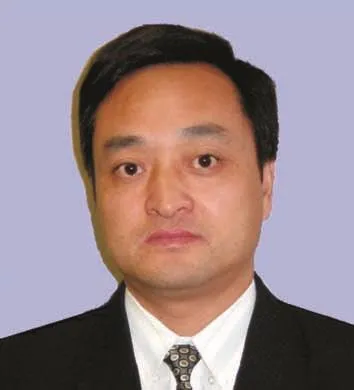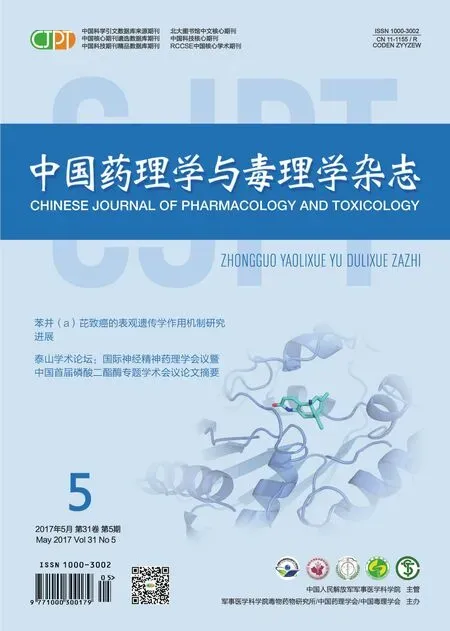专题3 睡眠、应激和干细胞:细胞与基因调控
HUANG Zhi-li
(Department of Pharmacology,School of Basic Medical Sciences;State Key Laboratory of Medical Neurobiology;Institutes of Brain Science and Collaborative Innovation Center for Brain Science, Shanghai Medical College,Fudan University,Shanghai 200032,China)
S3-2 In the dorsal raphe neucleus,the role of Ca2+,PKC and CaMKⅡin sleep-wake regulation
CUI Su-ying,CUI Xiang-yu,ZHANG Yong-he
(Department of Pharmacology,School of Basic Medical Science,Peking University,Beijing,China)
S3-3面向航天特因环境认知损伤及防护的动物行为实验技术
刘新民
(中国医学科学院药用植物研究所)
专题3 睡眠、应激和干细胞:细胞与基因调控
S3-1 Genetically engineered systems revealed the roles of basal ganglia in sleep-wake regulation
HUANG Zhi-li
(Department of Pharmacology,School of Basic Medical Sciences;State Key Laboratory of Medical Neurobiology;Institutes of Brain Science and Collaborative Innovation Center for Brain Science, Shanghai Medical College,Fudan University,Shanghai 200032,China)

黄志力,复旦大学特聘教授、博士生导师,上海医学院药理学系主任。担任Sleep Biol Rhythms和《中国临床药理学与治疗学》等杂志副主编、《中国药理学报》等10个杂志编委或常务编委。研究方向:睡眠与失眠机制、镇静催眠药物开发。发表SCI论文80篇,包括Nature Neuroscience,Light: Science&Applications,PNAS,Neuropsychopharmacology,Journal of Neuroscience等。2014,2015,2016年被列入爱思唯尔中国论文被高引学者榜单。主编《药理学》,副主编《中药药理实验方法学》等教材及大型参考书10余部。应邀为Trends Neurosci,Prog Neurobiol杂志撰写综述,为PNAS,J Neurosci等20个SCI杂志审稿。多次应邀赴美国、德国、法国、意大利、日本、澳大利亚等国家作学术报告。2005年获日本睡眠学会优秀研究奖,2006年获国家杰出青年科学基金,2016年获教育部科学研究优秀成果奖(自然科学二等奖)。
S3-2 In the dorsal raphe neucleus,the role of Ca2+,PKC and CaMKⅡin sleep-wake regulation
CUI Su-ying,CUI Xiang-yu,ZHANG Yong-he
(Department of Pharmacology,School of Basic Medical Science,Peking University,Beijing,China)

张永鹤,博士,教授,博士生导师,北京大学基础医学院药理学系副主任。长期从事睡眠及其共病机制和催眠新药研发等方面的工作。已在国内外杂志上发表论文80余篇,其中SCI收录论文60余篇。先后主持了科技部“十一五”国家重大新药创制项目、国家自然科学基金、教育部博士学科点专项基金-博导类、留学回国人员启动基金、美国中华医学基金-专项人才基金、北京大学“十五”211工程项目等科研项目。参编出版著作8本,包括八年制《药理学》教材、《神经精神药理学进展》、《神经药理学研究方法》、《神经精神药理学》和《新药药理学研究方法》等。已授权国际专利7项,国内专利1项。授权专利1项。担任中国药理学会副秘书长等学术兼职。
Abstract:OBJECTIVEDorsal raphe nucleus(DRN)is the largest single collection of neurons containing 5-HT in the entire brain and particularly attractive in a wide variety of complex physiological and behav⁃ioral processes,such as sleep-wake regulation.Calmodulin dependent kinaseⅡ(CaMKⅡ)and protein kinase C(PKC)are important signal-transducing molecules activated by Ca2+.Since the Ca2+modulation in DRN plays an important role in sleep-wake regulation,it should be presumed that the intracellular CaMKⅡ/PKC signaling in DRN may be involved in the regulation of sleep-wake.METHODSThe poly⁃somnogram consisting of EEG and EMG was recorded for analyzing sleep architecture.Immunohisto⁃chemisrty and Western-blotting methods were used in this study to investigate the roles of Ca2+,CaMKⅡand PKC in sleep-wake regulation in rat DRN.RESULTSCa2+in the DRN exert arousal effects by reducing the NREMs,SWS and REMs via up-regulating serotonergic functions and activating CaMKⅡ-PKC. However,inhibition of PKC leads to significant promotion of total sleep time especially the NREM sleep, but there were no changes in sleep parameters after the inhibition of CaMKⅡby its inhibitor KN-93 in DRN.CONCLUSIONThe molecular,pharmacological,and behavioral findings of this study demonstrate a novel wake promoting and sleep-suppressing role for the Ca2+/CaMKⅡ/PKC signaling pathway in DRN.Abnormalities in CaMKⅡ are found in patients with several neurological disorders that are associated with disturbed sleep,such as schizophrenia,depression,and Alzheimer′s disease.Several psychotropic drugs modulate CaMKⅡ activity.In addition,PKC is a cellular target of most current mood stabilizing and anti-manic agents and involved in bipolar disorder.The data of the present study raise the question whether PKC or CaMKⅡmodulations may also be effective on the sleep disorders or the mood disorders associated with sleep disorders.
Key words:calmodulin dependent kinaseⅡ;protein kinase C;sleep
Corresponding author:ZHANG Yong-he,E-mail:zhyh@hsc.pku.edu.cn
S3-3面向航天特因环境认知损伤及防护的动物行为实验技术
刘新民
(中国医学科学院药用植物研究所)

刘新民,中国医学科学院(北京协和医学院)教授、博导;世界卫生组织传统医学顾问;中国航天员中心客座研究员、国家载人航天工程医学领域专家。从事基于动物行为实验的中药神经精神药理和实验方法研究三十余年。在国内外学术刊物上发表学术论文150多篇,第一或通讯作者80余篇。培养毕业研究生40余名。
聚焦航天特因环境应激所致认知功能下降和损伤的预测、预警和防护,利用本团队前期自主研发的包括奖赏、被动回避和自发探索原理在内的认知行为检测分析系统,开展了狭小空间、节律紊乱和重力效应等多种模拟航天特因环境对动物认知功能损伤评价实验方法研究,建立了复杂操作任务下多重认知行为作业的定量检测分析。发现了航天特因模拟环境对认知作为作业损伤的效应累积强度和时间节点,以及不同认知作业的损伤特征。为我国航天特因环境所致认知损伤监测、预警与防护,保障航天飞行的顺利进行提供了功能完善、体系完整、高自动化和智能化的动物行为实验技术。
航天;认知损伤;医学防护
S3-4 EphB4信号通路对人胚胎神经干细胞自我更新、增殖、分化和凋亡的影响
王 文,刘婷婷,孙芳玲,魏仁平,艾厚喜,郭德玉,田 欣,祝自新,郑文荣,王宇峰
(首都医科大学宣武医院实验动物室,北京 100053)

王 文,教授,研究员,博士生导师,实验动物室主任,北京市卫生系统高层次卫生技术人才。从事中药药理、神经药理、天然药物化学专业研究工作,主要研究方向为中药、天然药物对重大疾病干预研究。兼任中国照明学会光生物光化学专业委员副主任委员;中国药理学会抗衰老及老年痴呆专业委员会秘书长;中华预防医学会老年病专业委员会秘书长;中国老年学会抗衰老科学委员会秘书长;中国药理学会补益药药理专业委员会副秘书长;中国药理学会抗炎免疫专业委员会理事;中国医师协会中西医结合神经病专业委员会理事;中国药理学会神经药理专业委员会委员等。已发表论文100多篇,其中SCI收录16篇。作为课题负责人,先后主持了卫计委和科技部牵头的2个国家重大专项“重大新药创制”和5个国家自然科学基金等十多项科学研究。参编中国科协《2049年的中国:科技展望》白皮书,参译第12版古德曼和吉尔曼的《治疗学的药理学基础》等著作。
摘要:目的本实验旨在研究EphB4是否参与调节了人胚胎神经干细胞的增殖、分化、凋亡活动,并探索其下游信号通路。方法培养原代人胚胎神经干细胞,使用沉默慢病毒与过表达慢病毒转染细胞,分别下调和上调EphB4蛋白表达水平。检测EphB4对细胞增殖、分化、凋亡的影响并探索其下游信号通路。结果EphB4基因沉默后,抑制细胞增殖及向神经元分化,促进细胞向胶质细胞分化,对细胞凋亡无影响。EphB4基因过表达后,促进细胞增殖及向神经元分化,抑制细胞向胶质细胞分化,对细胞凋亡无影响。EphB4是通过下游信号通路Abl-Cyclin D1调节细胞增殖,此信号通路不参与EphB4在细胞分化方面的调节。结论EphB4参与调节神经干细胞增殖,而且是决定神经干细胞向神经元分化还是向胶质细胞分化的开关,是调节干细胞增殖、迁移和分化的新信号通路,其很可能成为脑卒中后神经元修复的有效治疗靶点。
关键词:EphB4信号;人胚胎神经干细胞;细胞凋亡
S3-5 Preparation and evaluation of silymarin nanosuspensions for protective effects on stress-induced liver injury
WANG Xiao-dan1*,HAO Ji-fu2*,CHEN Wei1,WANG Hao1,WANG De-cai1,ZHANG Han-ting1,3
(1.Institute of Pharmacology,2.School of Pharmaccutical Sciences,Taishan Medical University,Tai′an 271016,China;3.Departments of Behavioral Medicine&Psychiatry and Physiology&Pharmacology,West Virginia University Health Sciences Center,Morgantown,WV26506,USA)
Abstract:OBJECTIVETo fabricate Silymarin(SM)nanosuspensions(NSs)and evaluate their protective effect on stress-induced liver injury.METHODSSM nanosuspensions were tailored by combination of the anti-solvent precipitation and high pressure homogenization(HPH);the formulations were optimized by central composite design.The pharmacokinetics and pharmacodynamics of SM-NSs were also performed.RESULTSIn light of the quadratic mathematical equations derived from the Design of Expert Software,the optimal formulation of SM-NSs consisted of PVP 0.34%and F188 0.36%.The morphology of NSs was found to be spherical with a diameter of about 150 nm using transmission electron microscope(TEM)observation.The pharmacokinetics experiment demonstrated that oral administration of SM-NSs signifi⁃cantly increased its bioavailability compared to the coarse powder(Cmax:9.03±2.39mg·L-1;AUMC0→∞:3757.35±227.19 mg·L-1·h;AUC0→∞:171.84±26.61 mg·L-1·h).In pharmacodynamics,it was found that restraint stress produced oxidative effects and increased serum AST and ALT levels in mice,both of which were significantly inhibited by SM and SM-NSs;in addition,administration of SM-NSs showed more effective prevention against acute liver injury than SM coarse suspensions(r2=0.986,0.984,P<0.05).CONCLUSIONThe results suggest that fabricated SM-NSs exert potent hepatoprotective effects and attenuate restraint stress-induced liver injury.The study provides an effective approach to improving the property of SM,which can be used for treatment of liver diseases.
Key words:silymarin;nanosuspensions;pharmcokinetics;stress-induced liver injury
Foundation item:The project supported by Natural Science Foundation of Shandong Province (ZR2014HL103,ZR2016HM21,J13LM51);Taishan Medical University Foundation(2014GCC15);and the Foundation of Overseas Distinguished Taishan Scholars of Shandong Province,China
Corresponding author:ZHANG Han-ting,E-mail:hzhang@hsc.wvu.edu,Tel:(0538)6231386
*Co-first author.
The basal ganglia(BG)act as a cohesive functional unit that regulates motor function,habit formation,and reward/addictive behaviors.However,it is still not well understood how the BG maintains wakefulness and suppresses sleep to achieve all these fundamental functions until genetically engineered systems developed these years.Significant research efforts have recently been directed at developing genetic-molecular tools to achieve reversible and cell-type specificin vivosilencing or activation of neurons in behaving animals.Optogenetic tools can be used both to specifically activate or inhibit neurons of interest and identify functional synaptic connectivity between specific neuronal populations,bothin vivoand in brain slices.Another recently developed system by Roth and colleagues permits the selective and″remote″manipulation(activation and silencing)of neuronal activity via all 3 major GPCR signaling pathways(Gi,Gsand Gq).These so-called″designer receptors exclusively activated by designer drugs″(DREADD)involve mutant GPCRs that do not respond to their endogenous ligands but are responsive to otherwise inert biological compounds.Recently,we demonstrated the essential roles and the neural pathways of the neurons expressing adenosine A2Areceptors or dopamine D1receptors in the BG for sleep-wake regulation using the genetically engineered systems including optogenetics and DREADD.We proposed a plausible model in which the caudate-putamen and the nucleus accumbens integrates behavioral processes with sleep/wakefulness through adenosine and dopamine receptors.
adeno-associated virus;optogenetics;DREADD;basal ganglia;sleep-wake regulation
HUANG Zhi-li,E-mail:huangzl@fudan.edu.cn
The project supported by National Natural Science Foundation of China(81573407, 81302746,81202511,81173031);National Mega-project of Scicence Research of China for New Drug Development(2009ZX09103-124);and Research Fund for the Doctoral Program of Higher Eductaion of China(20100001110048)

